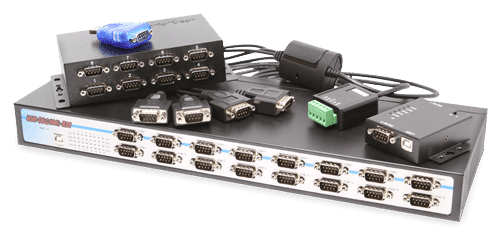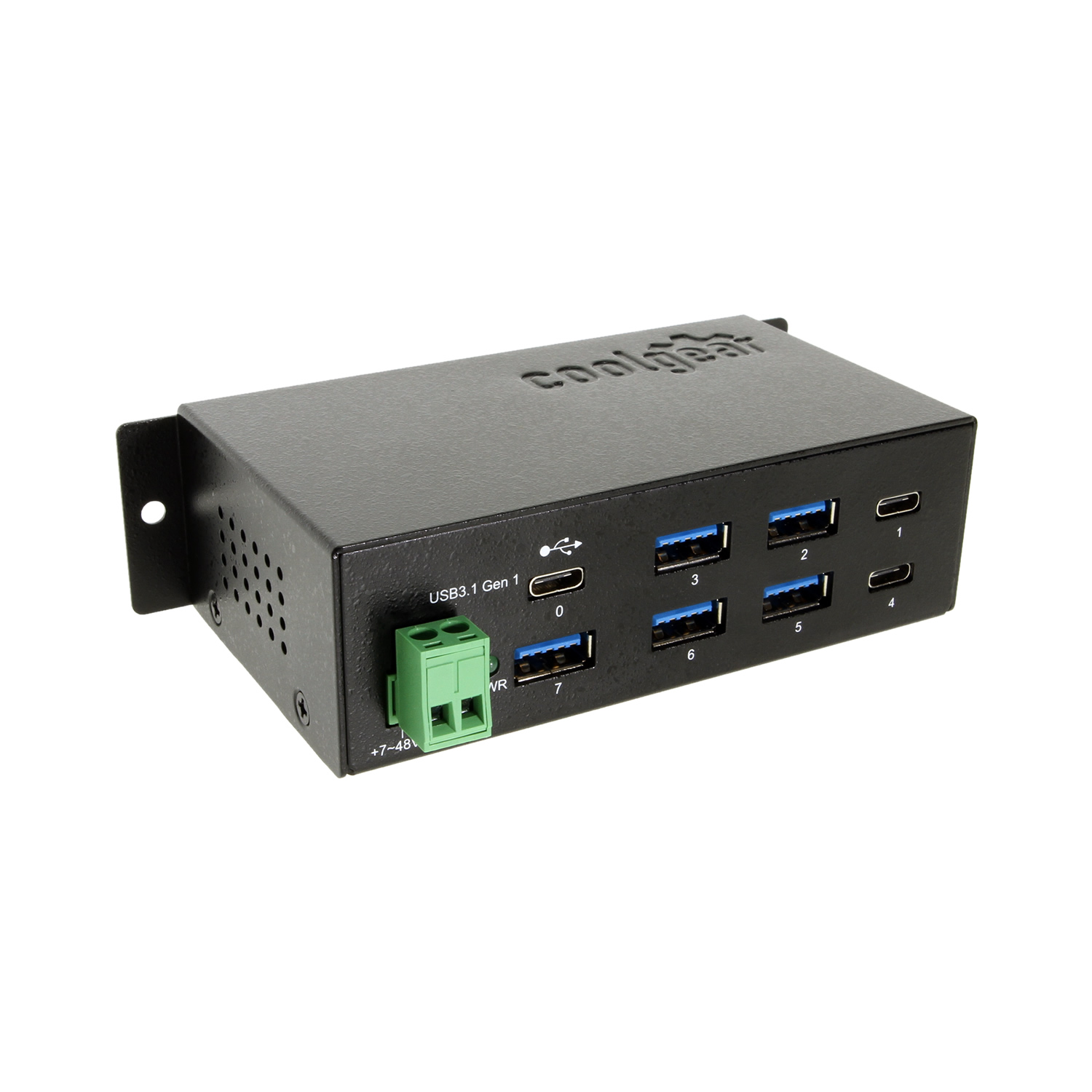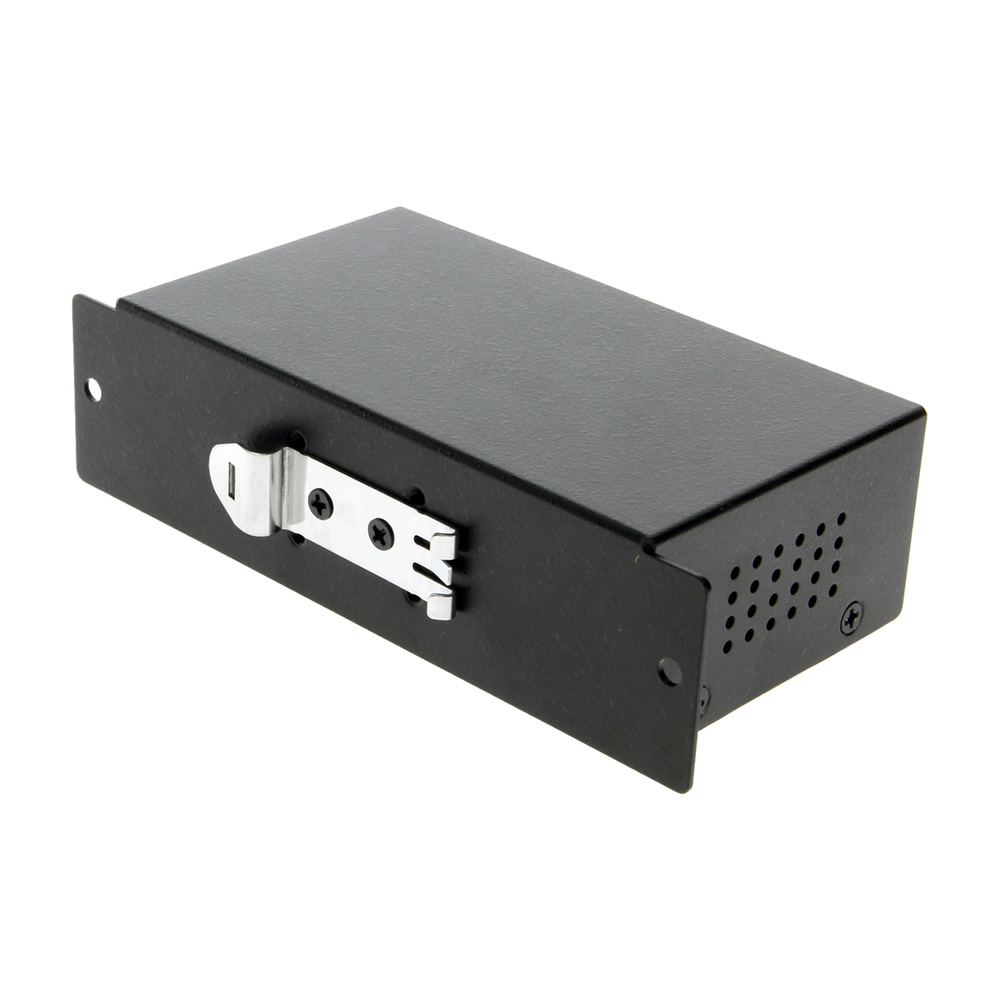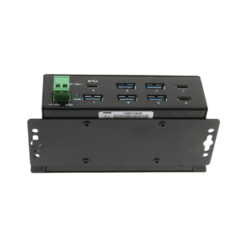Bulk Pricing
7 Port USB 3.2 Gen 1 Type-C Hub w/ ESD Surge Protection & USB-C Upstream
Industrial Grade | +7~48V DC Input | Surge Protection | Surface Mountable | DIN Rail | 5 Gbps
- Protect Your Equipment: The 7-port Type-C hub supports 15KV ESD surge protection for each port to keep your connected peripherals safe from harm.
- Super Fast Speeds: This USB hub is 3.2 Gen 1 compliant, ensuring super-fast 5Gbps data transfer speeds. It supports super speed, high speed and full speed which enables it to be compatible with USB 2.0 / 1.1.
- Superior Build Quality: Housed in a rugged steel chassis with built in mountable flanges, the 7-port hub is perfect for workstations installations in offices, labs, warehouses, and other industrial applications.
- Upstream: 1 USB-C port
- Downstream: 5 USB-A connectors, 2 USB-C port
- Power Connector: 2-Pin Terminal Block
- Mounting Options: Wall, Surface, & DIN Rail
$142.95
In stock
Volume Pricing
| Units | Discount | Price |
|---|---|---|
| 1 - 4 | — | $142.95 |
| 5 - 11 | 2 % | $140.09 |
| 12 - 24 | 5 % | $135.80 |
| 25 - 49 | 7 % | $132.94 |
| 50+ | 10 % | $128.66 |
Description
Introduction:
CoolGear’s new USB-C 7 Port Hub that is USB 3.2 Gen 1 specifications compliant, includes a metal constructed chassis and multiple mounting options. This USB-C Hub is an excellent choice for your USB 3.2 Gen 1 applications, it delivers up to 5Gbps and provides 1 USB-C Upstream port, 2 USB-C, and 5 USB-A downstream ports.
The USB-C hub is backward compatible with USB 2.0/1.1 compliant host using its RISC-like USB controller. It provides a unique self-power mode to work with wide range (+7 ~ 48V DC) input DC power from its terminal block (power adapter sold separately). It supports fast USB charging specifications by turning its downstream ports from a Standard Downstream Port (SDP) into Charging Downstream Port (CDP) or Dedicated Charging Ports (DCP).
Features & Specifications:
- Compliant with USB 3.2 Gen 1 Specifications
- Provides 1 USB 3.2 Gen 1 Upstream Port with USB-C connector
- Provides 7 USB 3.2 Gen 1 Downstream Facing Ports (with 2 USB-C and 5 USB-A Connectors) which manage up to 5Gbps
- Full-Featured USB-C Port Enables Reversible Plug Orientation and Cable Direction
- Supports 5Gbps, 480Mbps, 12Mbps and 1.5Mbps Speed
- Includes a Mounting bracket for flat surface mounting i.e. under desk, on walls or tech bench
- Supports Multi Transaction Translators per Hub
- Supports Wide Range Input (+7~48V DC) Self-power Mode from the Terminal Blocks (power adapter sold separately)
- Supports 15KV ESD Surge Protection for Each Port.
- Supports a 2-pin Terminal Block Connector for external power input from AC adapter
- Form Factor: 5.23inch(L) x 2.42inch(W) x 1.43inch(H) (13.30×6.15×3.63 cm)
Environmental Info:
- Operating Temp.: 0 to 55°C (32 to 131°F)
- Storage Temp: -20 to 85°C (-4 to 185°F)
- Operating Humidity: 5 to 95% RH
Supported Devices:
Supports keyboard, mouse, monitor, scanner, printer, PC Camera, telephone, DVD drive, joystick, virtual reality helmet, modem, PBX and many more USB devices
Package Contents:
- 7 port USB-C hub with DIN-Rail mounting kit
- DIN-Rail Clip with screws
- Mounting Bracket with screws
- 3ft. USB-A to C USB 3.1 Gen1 cable
*Surface Mounting screws not included.
- *Power Supply not included; available as an optional accessory: Model# 12V7A2P-B
Specifications
Product Specifications
| Power |
| ||||||||||||
|---|---|---|---|---|---|---|---|---|---|---|---|---|---|
| Compliance |
| ||||||||||||
| Physical Characteristics |
| ||||||||||||
| What's in the Box |
| ||||||||||||
| Software |
| ||||||||||||
| Environmental |
| ||||||||||||
| Product Information |
| ||||||||||||
| Hardware |
| ||||||||||||
| Performance & Safety |
| ||||||||||||
| Other Data |
|
Accessories & Replacement Parts
Accessories & Replacement Parts
The 7 port USB 3.1 USB Hub has certain accessories that work with it. These hub accessories are what you can order if needed for this hub.
Model# 12V7A2P-B
$29.95In stock
Model# CG-2PPW
$2.95In stock
Model# USB3-AC1MB
$7.99In stock
Model# DINRCLP3X
$5.95In stock
Support
Product Documentation & Drivers
Product Documentation
Need drawings, CAD files, or other compliance documentation? Click HERE
Relevant Articles & F.A.Q.
Relevant Articles
Product F.A.Q.
View frequently asked product questions below. Still need help? Reach out!
-
Can the hub be used without a power supply?
View AnswerIn some cases, yes. USB peripherals that only require low power (i.e. keyboards & mice) can be used without a power adapter. Power in this case is drawn from the host’s USB port.
When high-power USB peripherals are used, a power supply for the USB hub may be required. In other cases, the USB peripheral may require their own power adapters, in this case, a power supply for the hub may not be required. Without ample power though, the USB hub or connected peripherals may not operate correctly. It is recommended to use an included power supply when possible.
-
After waking up from sleep mode, my computer/host no longer recognizes my USB device.
View AnswerIf the USB device does not function properly after your computer or host has been in sleep mode, it is likely that Windows turned off the USB Root hub in order to save power.
To prevent this, follow the steps below (depending on your operating system).
Windows 10 / 8
- On your keyboard, press the Windows key + X and select Control Panel.
- Click Hardware and Sound, then click Power Options.
- Click Change plan settings for the plan you want to change.
- Click Change advanced power settings.
- Click the plus sign (+) next to “USB settings” and “USB selective suspend setting” to expand the options and change the setting to Disabled.
- Click OK to apply the setting.
Note: You may need to disconnect and re-connect your USB device after applying these settings.
Windows 7 / Vista
- Click the Start button and select Control Panel.
- Click Hardware and Sound, then click Power Options.
- Click Change plan settings for the plan you want to change.
- Click Change advanced power settings.
- Click the plus sign (+) next to “USB settings” and “USB selective suspend setting” to expand the options and change the setting to Disabled.
- Click OK to apply the setting.
Note: You may need to disconnect and re-connect your USB device after applying these settings.
Windows XP
- On your desktop, right-click the My Computer icon and select Properties.
- Click the Device Manager tab.
- Expand Universal Serial Bus controllers by clicking the arrow to the left of it.
- Right-click the first USB Root Hub device and select Properties.
- Click the Power Management tab.
- Clear the box next to Allow the computer to turn off this device to save power.
- Click OK to apply the setting.
- Repeat steps 4-7 for any remaining devices in the Universal Serial Bus Controllers section with “Root Hub” in the name.
Note: You may need to disconnect and re-connect your USB device after applying these settings.
-
The hub is properly hooked up, but is not functioning correctly. What can I do?
View AnswerTesting all setup components is the best place to begin troubleshooting. To determine the source of the issue, individually test your:
- USB Cable by using it in another setup, or trying another cable.
- Host USB Port by connecting another device or thumb drive.
- Connected Peripherals by connecting directly to the host.
Moving on to troubleshooting the hub itself. Attach a USB peripheral. The USB hub itself will not appear in hardware listings on your host’s system. USB devices connected however, will appear when connected. If the connected device is still not being found, try:
- Installing the required drivers for the USB peripheral.
- Install the most recent drivers for the USB controller and/or motherboard chipset.
USB hubs do not require drivers or software.
Troubleshooting the desired USB peripheral may be in order. If the peripheral is still not being recognized, attempt:
- Attaching external power to the peripheral, if required.
- Confirming if the peripheral functions on a standard USB port.
- Testing if basic USB peripherals work, such as keyboards or mice.
-
How can external power be connected to the industrial USB hub?
External power is supplied by connecting to the terminal block located on the hub. For when an external power adapter is required check out the Accessories & Replacement Parts section on this product page. To view all of our hub accessories and power supplies, visit the category here.
How to properly choose a power supply.To determine the power requirements, the equation to use is P = 5 * I * N, where:
P is the power wattage.
5 is the USB port voltage.
I is the current of the USB port in Amps (USB 2.0 is 0.5A, USB 3.0 is 0.9A.
N is the number of USB ports.
As an example using the equation, a 4 port hub would reflect a minimum wattage of 18 watts.
Knowing the minimum requirement, a proper power adapter can be chosen. In this case the voltage of a power supply should be within 7 to 24 or 7 to 40 Volts DC, depending on the specifications of the USB hub. Also, the power supply must convert AC to DC (no AC output).
Power supplies often come with a voltage (V) rating and an amperage (A) rating. To determine the current in amps, use I = P / V, where the following is true:
I is the current of the power supply.
P is the calculated power of the hub.
V is the chosen voltage of the power supply
Continuing the example, the 4 port hub requires 18 W and the power supply you choose is 12V, the current of the power supply would be I = 18/12, I = 1.5A.
Our full collection of power adapters can be found here.





























































Galen –
Powerful USB hub with diverse port types.
I power this hub directly from a 24v DC off grid power system. It’s everything I needed. It has USB C ports with full power so it can rapid charge phones. It has plenty of USB 3.1 ports for everything else. It seems like it is durably built. Would be nice if the power input was not on the same face as the USB ports. I’ve run this off of a battery bank that has ranged from 28 to 22 volts and this hub seems to function just fine on that range.